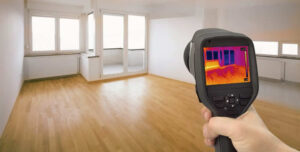6 Ways to Locate Hidden Water Leaks in Your House
6 Ways to Locate Hidden Water Leaks in Your House
Blog Article
We've noticed this article about Finding hidden leaks below on the internet and decided it made perfect sense to discuss it with you on this page.

Early discovery of leaking water lines can minimize a possible catastrophe. Some small water leaks might not be noticeable.
1. Analyze the Water Meter
Checking it is a guaranteed way that assists you uncover leaks. If it relocates, that indicates a fast-moving leakage. This implies you might have a slow leakage that could also be below ground.
2. Check Water Intake
Evaluate your water costs as well as track your water consumption. As the one paying it, you must notice if there are any disparities. If you find sudden changes, regardless of your consumption being the same, it suggests that you have leaks in your plumbing system. Keep in mind, your water bill need to fall under the very same variety monthly. An unexpected spike in your bill suggests a fast-moving leakage.
On the other hand, a constant increase each month, despite having the same practices, reveals you have a slow-moving leakage that's likewise slowly intensifying. Call a plumber to completely inspect your property, especially if you feel a warm area on your flooring with piping beneath.
3. Do a Food Coloring Examination
When it concerns water consumption, 30% comes from commodes. Test to see if they are running correctly. Drop specks of food color in the container and also wait 10 mins. There's a leakage in between the storage tank as well as bowl if the color in some way infiltrates your dish during that time without flushing.
4. Asses Exterior Lines
Don't neglect to inspect your exterior water lines also. Needs to water seep out of the link, you have a loose rubber gasket. One tiny leak can waste bunches of water as well as spike your water expense.
5. Inspect as well as Analyze the Circumstance
Property owners need to make it a practice to inspect under the sink counters and also even inside closets for any kind of bad odor or mold development. These 2 warnings suggest a leak so timely interest is called for. Doing routine inspections, even bi-annually, can conserve you from a major trouble.
If you understand your house is already old, maintain a careful eye on your heaters, hose pipes, pipelines and so on. Check for discolorations as well as damaging as most appliances and pipes have a life expectancy. They will likewise naturally deteriorate because of tear as well as use. If you believe leaking water lines in your plumbing system, don't await it to escalate. Call a professional plumber as soon as possible so you don't wind up with a terrible mess in your home.
Early detection of leaking water lines can mitigate a possible calamity. Some small water leakages might not be noticeable. Inspecting it is a guaranteed means that aids you discover leakages. One small leak can squander loads of water and spike your water costs.
If you presume leaking water lines in your plumbing system, don't wait for it to rise.
WARNING SIGNS OF WATER LEAKAGE BEHIND THE WALL
PERSISTENT MUSTY ODORS
As water slowly drips from a leaky pipe inside the wall, flooring and sheetrock stay damp and develop an odor similar to wet cardboard. It generates a musty smell that can help you find hidden leaks.
MOLD IN UNUSUAL AREAS
Mold usually grows in wet areas like kitchens, baths and laundry rooms. If you spot the stuff on walls or baseboards in other rooms of the house, it’s a good indicator of undetected water leaks.
STAINS THAT GROW
When mold thrives around a leaky pipe, it sometimes takes hold on the inside surface of the affected wall. A growing stain on otherwise clean sheetrock is often your sign of a hidden plumbing problem.
PEELING OR BUBBLING WALLPAPER / PAINT
This clue is easy to miss in rooms that don’t get much use. When you see wallpaper separating along seams or paint bubbling or flaking off the wall, blame sheetrock that stays wet because of an undetected leak.
BUCKLED CEILINGS AND STAINED FLOORS
If ceilings or floors in bathrooms, kitchens or laundry areas develop structural problems, don’t rule out constant damp inside the walls. Wet sheetrock can affect adjacent framing, flooring and ceilings.
https://www.servicemasterbyzaba.com/blog/how-to-detect-water-leakage-in-walls/

We were made aware of that report on Leaking water lines from an acquaintance on another domain. If you liked our blog post if you please be sure to pass it around. Many thanks for your time spent reading it.
Report this page